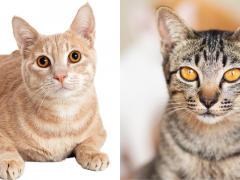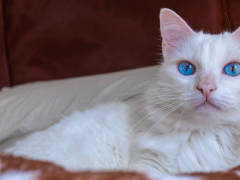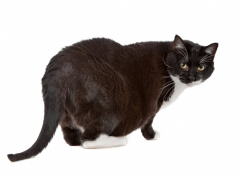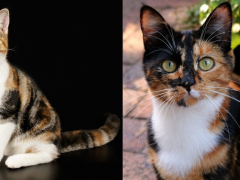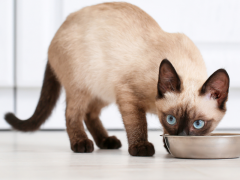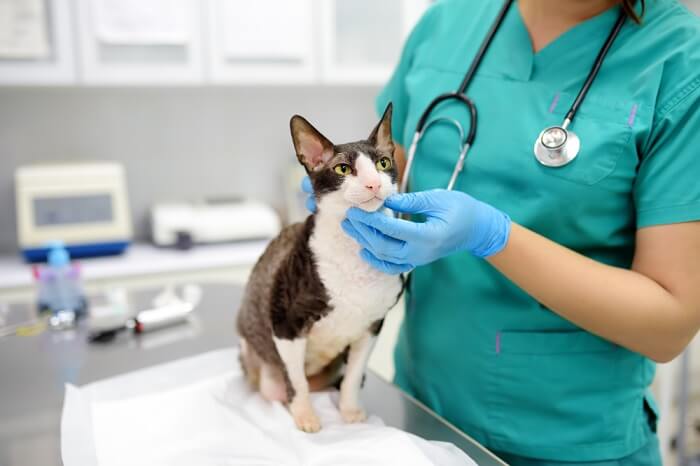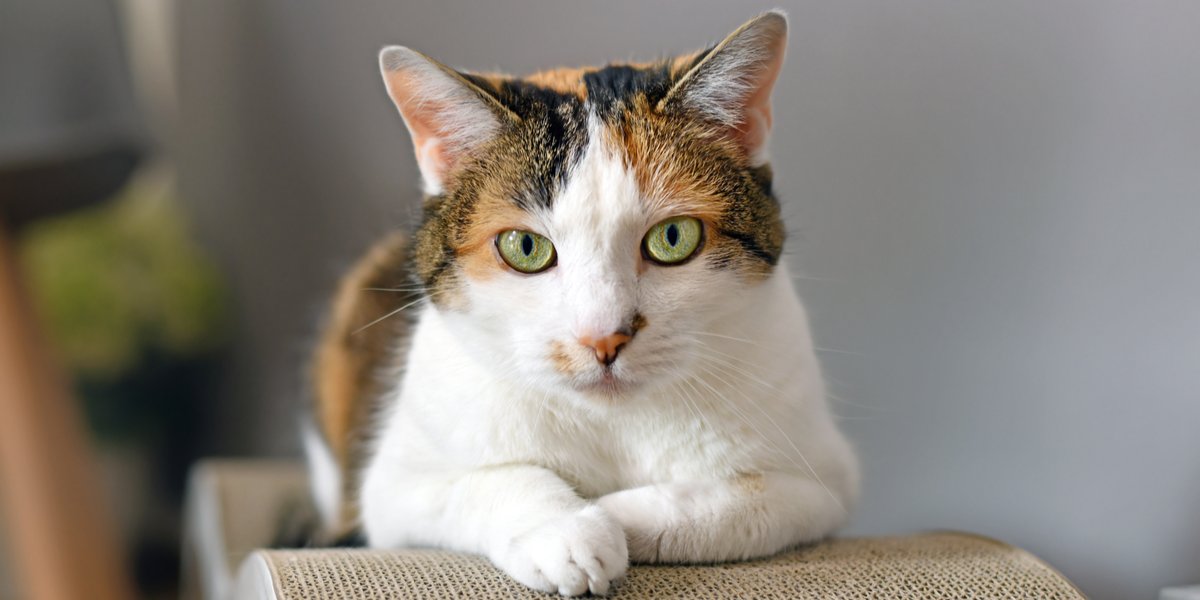
Whether you’re thinking about getting a cat yourself or not, you’ve probably come across the wonderful calico at some point. Who hasn’t?
What Makes Calico Cats So Special?
Calico cats have an air of mystery about them along with a rich history, not to mention their unique appearance…
But what really makes calico cats so special?
They aren’t even a breed of cat! Calicos get their name from the coloration of their coat!
In this post, we’ll tell you everything you need to know about calico cats, along with 10 fun facts about them. Let’s dive in!
Calico Cat Appearance
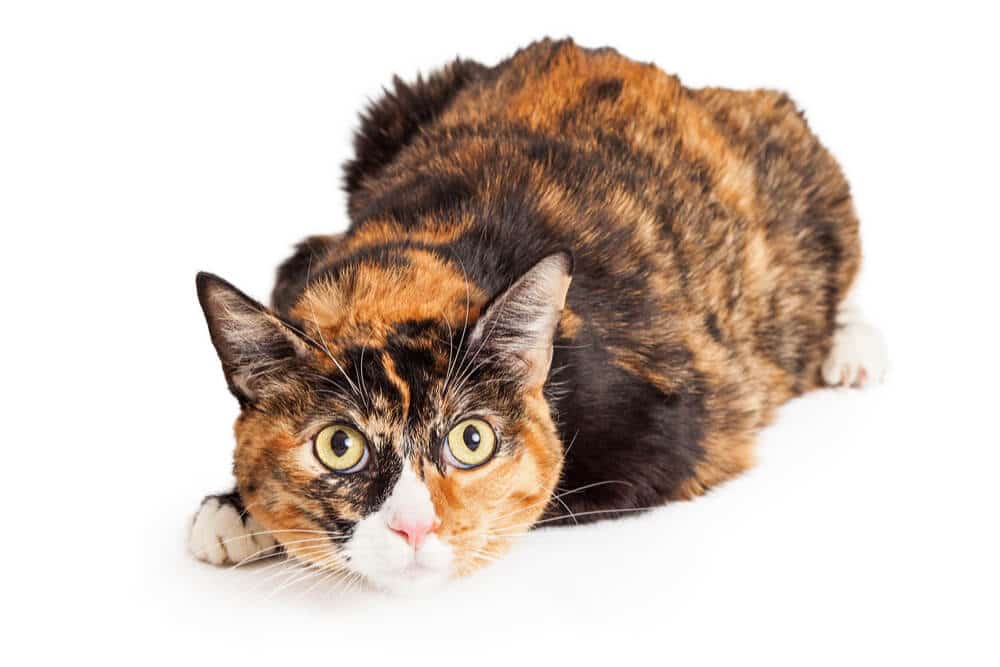
Because calico cats are not a breed unto themselves, calicoes will have unique and varied personalities influenced by a wide range of factors.
Calicoes are often described as the world’s most colorful cats. After all, they are one of the only cats to exhibit such a wide range of color variations in its coat.
The calico is not a breed of cat but a domestic cat with a variety of genetic color variations.
The most common calico is a tri-color pattern of orange, black, and white. It is possible, however, to have a calico pattern with shades of cream, red, blue-black, and even chocolate brown.
Calicoes with less intense coloration are known as dilute calico cats. They are primarily white in color with patches of light color ranging from blue-gray to cream to strawberry blonde.
You can find calico cats across many distinct breeds with the exception of solid-color and pointed breeds like the Bombay, Russian Blue, British Shorthair, Siamese, and Himalayan. Because calico cats occur across so many different cat breeds, it’s sometimes hard to tell whether the cat is a calico or actually a tortoiseshell.
The best way to tell is to examine the calico patches.
A tortoiseshell cat usually has the primary colors (red and black) woven throughout the coat while a calico will have distinctive solid-colored patches (like black patches or white patches).
Some of the breeds you can find in calico appearance include Maine Coon, Manx, Persian, American Shorthair, Japanese Bobtail, Siberian, and more.
Personality and Behavior
Calico cats aren’t a breed unto themselves, so we can’t assign breed-specific personality or behavioral traits to them. Like many cats, calicoes will develop their unique personalities according to many factors, such as socialization and life experiences.
Because calico cats are so different from one another, it’s particularly exciting to get one.
You could get a laid-back, mellow cat that enjoys being around you and wants to be your loyal companion.
You could also get the opposite: an aloof, high-maintenance cat with an attitude.
That being said, many calico owners report that their cats share a similar personality with tortoiseshell cats – they called it “tortitude.”
Torties are known for being spunky, sassy, and independent by nature. Calico cats may share these characteristics but, like we mentioned, you never quite know what you’re going to get. Plus, calico cats can’t be bred, so they’re even less likely to share common characteristics.
Mysterious Genetics
The genetics of calico cats are quite fascinating and have long been the topic of scientific research. We could really get into the weeds about these genetics, but your eyes might glaze over. So, we’ll keep this as short and simple as possible.
The black and orange patches of fur that characterize these cats are a result of the genetic phenomenon called “X-chromosome inactivation”.
You could have a orange tabby with calico patches of white fur or black fur just as easily as a black cat with calico patches of white and orange fur.
Are Calico Cats Always Female?
In cats, the gene that dictates fur color is located on the X chromosome. Nearly all calico cats are female, so they have two X chromosomes. The rare male calico cats have one X and one Y chromosome.
In addition to determining a cat’s coat color, X chromosomes have numerous genes that code for proteins that are necessary for survival.
With females having two X chromosomes, this double dose of ‘survival’ genes could be toxic. To compensate for this double dose, one of the X chromosomes is randomly inactivated when the calico kitten is just a tiny ball of cells in the mother’s womb.
Thus, if the X chromosome carrying the gene for white fur in one particular spot of the body is inactivated, the orange gene might become active in that spot instead (and vice versa). Because the deactivated chromosomes are chosen randomly, the combination of fur colors in calico cats is also random and unique for every calico cat.
Health and Lifespan
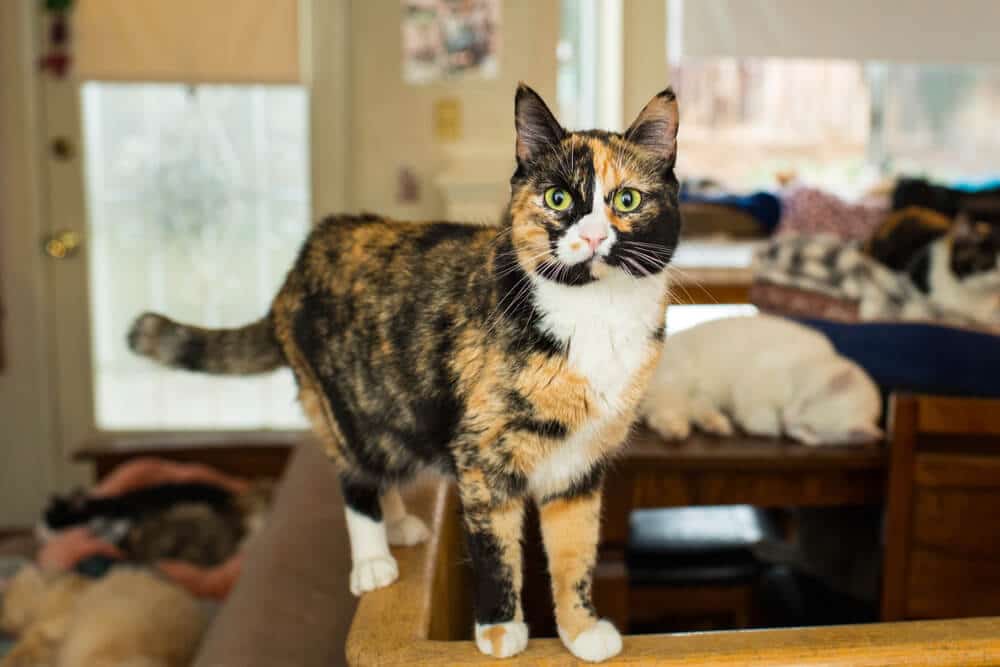
While the rare male calico may encounter some health issues and have shorter life expectancies, female calico cats are just as healthy as cats with other coat patterns, with an average lifespan of 12 to 16 years.
The average lifespan of calico cats is 12 to 16 years. Is this more or less than the average lifespan for most cat breeds?
Yes and no. It depends if the calico cat is male or female.
Male calicoes tend to live shorter lives than female calicoes because of a genetic condition called Klinefelter’s Syndrome. This syndrome is the presence of two X chromosomes and one Y chromosome – in other words, a male calico cat has an extra X chromosome.
Klinefelter’s Syndrome can lead to numerous health problems, such as the increased risk of broken bones, joint pain, and diabetes. These health problems can result in shorter lifespans for male calicoes.
Regardless whether your cat is a male or female calico, you can help them have a good quality of life by providing them with good shelter, feeding them a nutritious diet, and providing quality veterinary care with the help of a solid pet health insurance plan.
How Rare Are Male Calico Cats?
Male calicoes are rare. A study by the University of Missouri’s College of Veterinary Medicine estimated that only 1 in 3,000 calico cats are male.
The good news is that 99.9% of calico cats are female because of this unique genetic makeup. But put worries aside, because just like with any cat, a calico cat can live longer than average if provided the best health care along with a healthy and balanced diet.
Calico vs. Tortoiseshell Cats and Tabby Cats
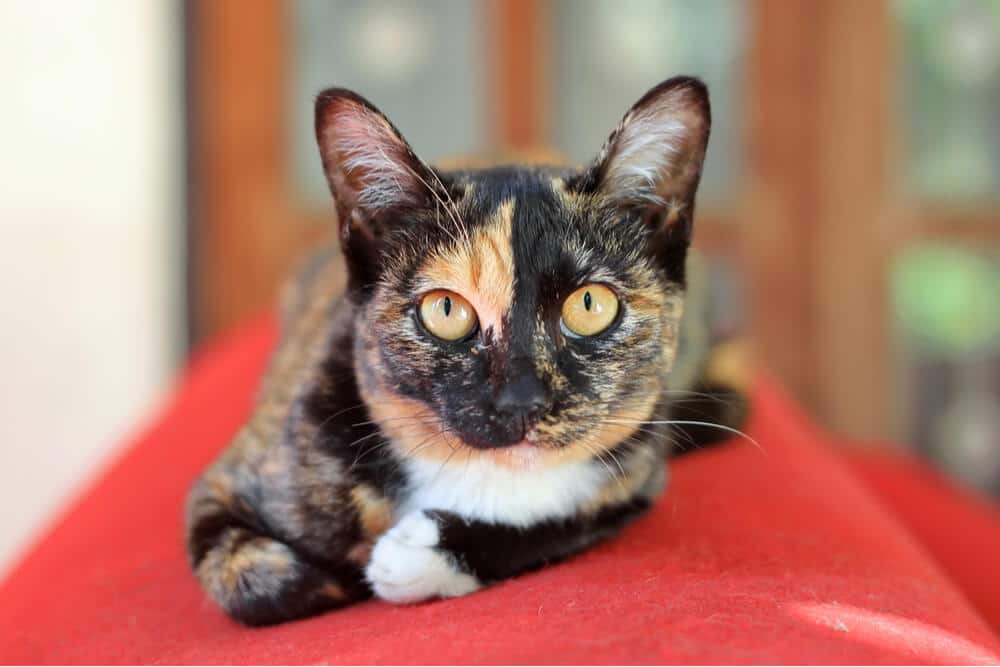
All calico cats have tricolor coats, but these coats also come in other patterns, like tortoiseshell.
Calico cats aren’t the only cats with unique coat colors. Tortoiseshell cats (aka, torties) and tabby cats have them, too. It can be tricky to differentiate a calico from these other cats, so we’ll help you out.
Calico cats have three coat colors (white, orange, and black), while torties typically are bi-colored (marbled orange and black). Torties have very little white coat, which usually appears as small spots on the face, chest, or paws.
Tabbies have an unmistakable ‘M’ on their forehead. Calicoes don’t have this on their forehead, so that is an easy-to-spot difference between calicoes and tabbies. Also, tabbies have distinct tabby stripes, along with prominent ginger and black patches.
10 Fun Facts About Calico Cats
- Females dominate – The unique genetics of calico cats that determine coat color mean that 99.9% of calico cats are female cats. Remember, coat color is linked to female sex chromosomes (XX).
- Nearly all male calicoes are sterile– Male calicoes often have Klinefelter’s syndrome (XXY chromosomal makeup), a genetic condition that causes sterility, among many other health problems.
- They represent a state – Because of their color, calico cats were declared the official state cat of Maryland in 2001. A calico cat’s fur colors are a mixture of white, black, and orange, the same as feather colors of the Baltimore Oriole, which is Maryland’s state bird. Only two other states have state cats!
- Beckoning cat -The famous Beckoning cat character is based on a calico cat.
- Different names – Calico cats have different names in different cultures. For example, they are called “lapjeskat” in the Netherlands, which means “patched cat”, and “mi-ke” in Japan, which stands for “triple fur”.
- Lucky charm – Given their rarity, calico cats are known as lucky charms and signs of good luck around the world. People also believe that calico cats bring good fortune to the homes of families who adopt them. Another fun fact is that they are sometimes referred to as money cats in the United States. In the 1870’s, calico cats were declared an official symbol of fortune in Japan (Maneki-Neko).
- Calicoes are brave – A calico cat saved Japan’s railway station from being closed down. In 2007, the Kinokawa train station was about to be closed due to budget issues. As a last resort, the town sent a local calico cat to be station master, where she would greet passengers as they passed by. The calico cat became a celebrity, causing a 17% increase in station traffic. The calico cat’s good luck is indeed true.
- Calicoes are everywhere – Considering how rare calico cats are, they have really spread around the world. Calico cats were traced migrating along routes in Europe and Northern Africa. Even though they originated in Egypt, they were also found in cities along the Mediterranean, France, Italy, and Spain.
- You cannot breed them– You can’t breed a calico cat because they happen only by chance. This chance occurrence is why they are so rare and considered to be a lucky charm.
- They cure warts – While it’s just a rumor, it’s often believed that calico cats can cure warts. Rubbing warts against the tail of a calico cat in May is supposed to cure it. We are not sure if this is true, but we are sure that the cats probably don’t enjoy it!
Happen to have a calico cat? Know anyone who does? Tell us about it in the comments below!
Wish you could learn more about the genes that make your cat special? Cat DNA testing could be the answer. Click here to read our review of the Basepaws cat DNA test kit.
Frequently Asked Questions
Are all calico cats female?
Yes, for the most part. Because their coloring is linked to the X chromosome and cats with two X chromosomes (XX) are female, 99.9% of all calico cats are female. It is possible for a calico cat to be male, but it is exceedingly rare.
Can calico cats be male?
Though it is very rare, male calico cats do exist. Male calico cats are most likely to have a chromosomal abnormality that gives them two X chromosomes and one Y chromosome (XXY).
How long do calico cats live?
Calico is a coloration rather than a breed, so it’s difficult to say whether calico cats are different from other cats in terms of lifespan. Indoor calico cats generally live 12 to 16 years while outdoor cats have shorter lifespans around 7 to 9 years.
How rare are male calico cats?
According to a study conducted at the University of Missouri’s College of Veterinary Medicine, only 1 in every 3,000 calico cats is male. Because they are so rare, they are often considered good luck charms.
Are calico cats mean?
Owners of cats with sex-linked color patterns (like tortoiseshell or tortie cats) often report a higher frequency of aggression than owners of cats with other colors. Calico cats aren’t always “mean,” per se, but they do tend to be more independent than other cats.
